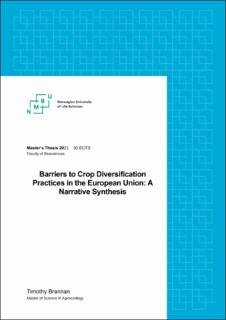| dc.description.abstract | Crop diversification covers different farm-level practices such as extending crop rotations, intercropping, multicropping, and strip cropping. Irrespective of the well-documented farmlevel and societal benefits derived from crop diversification (Kremen and Miles, 2012), European farmers’ adoption rates have been low (Kassam et al., 2015; Lahmar, 2010; Magrini et al., 2016; Voisin et al., 2014; Watson et al., 2017). This research explores crop diversification practices that produce a marketable crop, examining their low uptake at the farm-level, upstream and downstream of the farm, and considering the broader agri-food system. This requires a holistic systems approach, like agroecology, which integrates ecological, economic, and social dimensions (Francis et al., 2003; Méndez et al., 2015). More specifically, I synthesis barriers to crop diversification at the farm-level and along the supply chain and explore the relationships between barriers to different crop diversification practices and relationships between barriers and different markets and their respective value chains. To achieve these aims, I conduct two systematic-like reviews: a literature review of peerreviewed review papers on the adoption of crop diversification practices in Europe and a review of the outputs from six European Union research projects making up the European Crop Diversification Cluster (CDC). This synthesis supports previous research demonstrating that barriers are context-dependent, interconnected, and occur at multiple levels. Six main findings emerged. First, the results support previous research demonstrating a lock-in to simplified farming systems which focus on major crops and agro-chemicals. Second, the findings suggest that the technical and economic performance in terms of yield and profitability were less significant barriers for farmers than previous reviews indicate. Third, a lack of knowledge and access to support or advice were critical barriers for farmers. Fourth, non-economic factors influenced farmers’ decision-making. Fifth, specific markets and value chains impact barriers; the results demonstrate that commodity and alternative markets and their respective value chains have distinctive barriers. Sixth, intercropping has specific barriers, predominantly regarding the separation of mixtures and the need for specialised machinery and infrastructure both on- and off-farm. | en_US |

